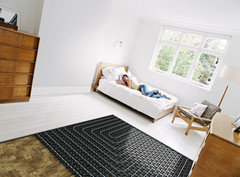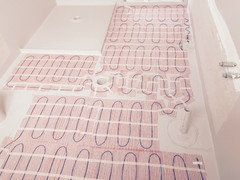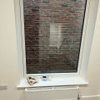Underfloor heating — worth the investment?
Gioenne Rapisarda
8 years ago
last modified: 6 years ago
Featured Answer
Sort by:Oldest
Comments (139)
james8896
6 years agoFrank Ansell
6 years agoRelated Discussions
Warmfloor 24V underfloor heating...does anyone have it?
Comments (20)As said ... it all depends on the heat loss of your building / room. A passive house (with near-zero heat loss / with actual gain) can be "heated by a candle", and it's actually a problem in such places getting the heat from, say, cooking "out" of it (don't get an Aga if you have a passive house !). On the other end, a drafty 1890's victorian terrace with an EPC E will leak heat so badly - floors, walls, roofs, windows - that no efficient heating system replacement will get it warm. That the old cable-based electric underfloor heating "cooks" your feet is true (my parents "upgraded" their 1980's electric UfH to radiators around 20 years ago ... because of that as well as the running cost). That carbon-film-based electric underfloor heating with its nice and even heat distribution is a much more comfortable "feeling" is also correct. But if your heat loss notably exceeds the ability of of your heating system to introduce heat ... it won't get warm. "Wattage" ... is just a measure of heat loss / gain, Energy-per-time. If you loose heat at a rate of 1kW then you need to introduce heat at that rate to keep the room temperature the same. My advice is: Get a heat loss calculation done first, before you embark on installation of underfloor heating. The manufacturers are usually rather willing to help with that, to make sure what gets installed is suitable for purpose....See Moreunderfloor heating - have you done it?
Comments (8)We have recently purchased a new build with wet undlerfloor heating throughout, also a bungalow. We have engineered wood floor (floating) through whole house except for ensuite and bathroom which are ceramic tile. It does give a lovely even heat and you have the flexibility to control each room individually. You are correct that it is not super quick to respond because it is heating such a large surface area but this is not something I have found to be a problem at all. It only really gets moved up and down about 3 degress anyway. We have our bedroom very low because we like a cool room and this works well. Our house is 4 bedroom, approx 136 sqm and at the moment our heating and electric is working out at about £70 a month (this is for everything, no gas or anything on top of this) however, we do have airsource heat pump which adds further to efficiency of the heating. Also, if it is useful, the cost for us of the UFH installation was about £5500 but this was in new build and not retrofit. If you have a well insulated house I would go for it! :)...See MoreUnderfloor heating for half a room?
Comments (7)Rinq - Perfect, I think you're right, having the warm floor over a large area will still be really nice. Good idea about checking the calculator for the heating requirements. We're being given some hydraulic plinth heaters, including one on the island, facing towards the living room which will heat both rooms up as well. and we can obviously turn them off if not needed/excessively noisy (although I've purposely chosen mostly the quietest ones) Unfortunately I don't think we've got the funds for the initial outlay of solar panels. Maybe in a few years, But yes, I think we'll have enough heat output for the space but just wondered if it was too "weird" to have only part of a room with UFH. Forzaitalia - I'm sorry to hear your step-daughter's electric UFH stopped working! that must have been so frustrating after the cost of buying it and installation! Did she manage to claim her money back under warranty?...See MoreInsulating garage's concrete floor for electric underfloor heating
Comments (0)Hello! I have a 12m2 garage with a concrete floor that I would like to insulate and use electrical underfloor heating as it will become a home office. I'm doing it all myself but I’m not sure what is the best procedure and/or order of putting it all together. My first idea was first to repair cracks and holes with mortar, then self level it as the concrete surface is full of tiny waves/grooves, lay a damp proof membrane, lay the 50mm PIR boards on top, then electric underfloor heating mats stick to the PIR boards, self-level again and then a laminated or vinyl floor. The concerns and questions I have or were raised by talking to some people * I may not need to self level the concrete slab to take these waves/grooves imperfections, the PIR boards once layed on top of them and walked on top should absorb these. True? * 50mm PIR boards for a 12m2 garage could be overkill? * PIR board should not be in direct contact with electric underfloor heating, I guess it can be burnt/melted by the wires? It seems I would need to add a separation layer, some suggested some concrete faced insulation boards so the heat from electrical wires would spread more evenly on the surface and not damage the PIR boards underneath * Should I chipboard on top of the PIR boards (which has the wires and self level already in place) as they are weak and could get damaged easily with point pressure even with the self-level on top? * Is chipboard the best option to add a hard layer between the PIR boards and the laminated floor? * I was checking screed, but the requirement seems to be 50mm of screed on top of underfloor heating wires and that with already 50mm PIR board means a fair bit of headroom gone, plus the curing time for screed of several weeks. I was checking liquid screed with faster drying times, but I'm not sure it is worth the costs...See MoreDeirdre Avenell
6 years agodeagan4455
6 years agojames8896
6 years agojames8896
6 years agoddarroch
6 years agotwistedstairway
6 years agoFrank Ansell
6 years agoFrank Ansell
6 years agojames8896
6 years agojames8896
6 years agoJWA Electrical
6 years agoFrank Ansell
6 years agoHunt Heating
6 years agolast modified: 6 years agoDanny Donagh
6 years agoDona Dimaculangan
6 years agoLuke Buckle
6 years agoSkye Lanser
6 years agoEnvirotecture
6 years agocustomheatquotes
6 years agorobynrauna
6 years agoHunt Heating
6 years agocustomheatquotes
6 years agoFrank Ansell
6 years agoEnvirotecture
6 years agoCatherine Epping
6 years agoFrank Ansell
6 years agoMmm Robinson
6 years agoFrank Ansell
6 years agoMmm Robinson
6 years agoEnvirotecture
6 years agoFrank Ansell
6 years agohjarman4312
5 years agoCustomheat Floor Heating
5 years agoTrish Power
5 years agoFrank Ansell
5 years agoTrish Power
5 years agopucciplan
5 years agoHU-36661073936
5 years agoMmm Robinson
5 years agoFrank Ansell
5 years agoMatt Gibson
5 years agofleurphelan
3 years agoMatt Gibson
3 years agofleurphelan
3 years agoHolly Clamp
3 years agolast modified: 3 years agoJulie H
3 years agoElham Mohammadi
10 months agoCustomheat Floor Heating
10 months ago










Belle Homes Design & Construction